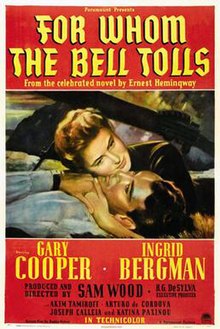
Katina Paxinou was a Greek film and stage actress.

Ingrid Bergman was a Swedish actress. With a career spanning five decades, Bergman is often regarded as one of the most influential screen figures in cinematic history. She won numerous accolades, including three Academy Awards, two Primetime Emmy Awards, a Tony Award, four Golden Globe Awards, BAFTA Award, and a Volpi Cup. She is one of only four actresses to have received at least three acting Academy Awards. In 1999, the American Film Institute recognised Bergman as the fourth greatest female screen legend of Classic Hollywood Cinema.

Gary Cooper was an American actor known for his strong, quiet screen persona and understated acting style. He won the Academy Award for Best Actor twice and had a further three nominations, as well as an Academy Honorary Award in 1961 for his career achievements. He was one of the top-10 film personalities for 23 consecutive years and one of the top money-making stars for 18 years. The American Film Institute (AFI) ranked Cooper at number 11 on its list of the 25 greatest male stars of classic Hollywood cinema.

For Whom the Bell Tolls is a novel by Ernest Hemingway published in 1940. It tells the story of Robert Jordan, a young American volunteer attached to a Republican guerrilla unit during the Spanish Civil War. As a dynamiter, he is assigned to blow up a bridge during an attack on the city of Segovia.
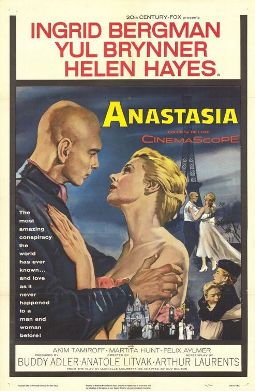
Anastasia is a 1956 American period drama film starring Ingrid Bergman, Yul Brynner, and Helen Hayes. The film was directed and written by Anatole Litvak and Arthur Laurents, adapting the 1952 play written by Guy Bolton and Marcelle Maurette. It was inspired by the story of Anna Anderson, one of the best known of the many Romanov Impostors who began to emerge after the Imperial family was murdered in July 1918.

Samuel Grosvenor Wood was an American film director and producer who is best known for having directed such Hollywood hits as A Night at the Opera, A Day at the Races, Goodbye, Mr. Chips, The Pride of the Yankees, and For Whom the Bell Tolls and for his uncredited work directing parts of Gone with the Wind. He was also involved in a few acting and writing projects.

Akim Mikhailovich Tamiroff was an Armenian-American actor of film, stage, and television. One of the premier character actors of Hollywood's Golden Age, Tamiroff developed a prolific career despite his thick accent, appearing in at least 80 motion pictures over a span of 37 years.

The General Died at Dawn is a 1936 American drama film that tells the story of a mercenary who meets a beautiful girl while trying to keep arms from getting to a vicious warlord in war-torn China. The movie was written by Charles G. Booth and Clifford Odets and directed by Lewis Milestone.

Tortilla Flat is a 1942 American romantic comedy film directed by Victor Fleming and starring Spencer Tracy, Hedy Lamarr, John Garfield, Frank Morgan, Akim Tamiroff and Sheldon Leonard, based on the 1935 novel of the same name by John Steinbeck. Frank Morgan received an Academy Award nomination for Best Supporting Actor for his poignant portrayal of The Pirate.

Renault Renaldo Duncan, better known as Duncan Renaldo, was a Romanian-born American actor best remembered for his portrayal of The Cisco Kid in films and on the 1950–1956 American TV series The Cisco Kid.

Vera Zorina, born Eva Brigitta Hartwig, was a Norwegian ballerina, theatre and film actress, and choreographer. Today, she is chiefly remembered for her films choreographed by her then-husband George Balanchine. They include the Slaughter on Tenth Avenue sequence from On Your Toes, The Goldwyn Follies, I Was an Adventuress with Erich Von Stroheim and Peter Lorre, Louisiana Purchase with Bob Hope, and dancing to "That Old Black Magic" in Paramount Pictures' Star Spangled Rhythm.
The 1st Golden Globe Awards, honoring the best achievements in 1943 filmmaking, were held late on January 20, 1944, at the 20th Century Fox studios in Los Angeles, California.
The 15th National Board of Review Awards were announced on 23 December 1943.
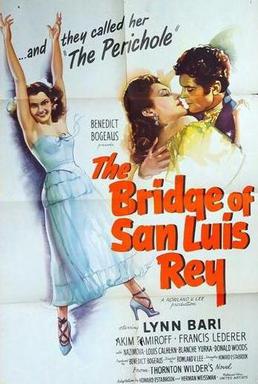
The Bridge of San Luis Rey is a 1944 drama film made by Benedict Bogeaus Productions and released by United Artists. It was produced and directed by Rowland V. Lee with Benedict Bogeaus as co-producer. The screenplay by Howard Estabrook and Herman Weissman was adapted from the 1927 novel The Bridge of San Luis Rey by Thornton Wilder. The music score was by Dimitri Tiomkin and the cinematography by John W. Boyle and an uncredited John J. Mescall. The film stars Lynn Bari, Francis Lederer, Akim Tamiroff, Nazimova and Louis Calhern.

Desire is a 1936 American romantic crime comedy-drama film directed by Frank Borzage, starring Marlene Dietrich and Gary Cooper, and produced by Borzage and Ernst Lubitsch. The picture is a remake of the 1933 German film Happy Days in Aranjuez. The screenplay was written by Samuel Hoffenstein, Edwin Justus Mayer, and Waldemar Young, based on the play Die Schönen Tage von Aranjuez by Hans Székely and Robert A. Stemmle. The music score was composed by Frederick Hollander and the cinematography was shot by Charles Lang and Victor Milner. Marlene Dietrich's wardrobe was designed by Travis Banton. The supporting cast features John Halliday, William Frawley, Akim Tamiroff, and Alan Mowbray.
For Whom the Bell Tolls is a British television series first aired by BBC in 1965, based on the 1940 novel by Ernest Hemingway. It stars John Ronane, Ann Bell, Julian Curry, Glynn Edwards and Joan Miller. The film was adapted for television by Giles Cooper, was produced by Douglas Allen, and was directed by Rex Tucker. It consisted of four 45-minute episodes, the first of which aired on 2 October 1965. The last episode aired 23 October 1965. According to the BBC archives none of the episodes of the film still exist.
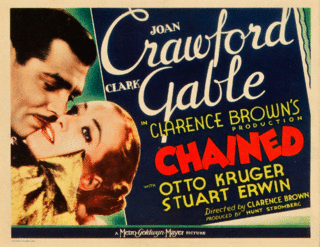
Chained is a 1934 American drama film directed by Clarence Brown and starring Joan Crawford and Clark Gable with supporting performances by Otto Kruger, Stuart Erwin, Una O'Connor and Akim Tamiroff. The screenplay was written by John Lee Mahin, Albert Hackett and Frances Goodrich based upon a story by Edgar Selwyn. Ward Bond and Mickey Rooney appear briefly in uncredited roles.

Irving Goff was a member of the Communist Party USA and the Abraham Lincoln Battalion, a unit that volunteered to fight during the Spanish Civil War for the Popular Front. During World War II, he was a member of the American Office of Strategic Services, and was instrumental in setting up guerrilla units working behind enemy lines in North Africa and Italy. His exploits as a guerrilla in Spain are considered to be the inspiration for Ernest Hemingway's novel For Whom the Bell Tolls.
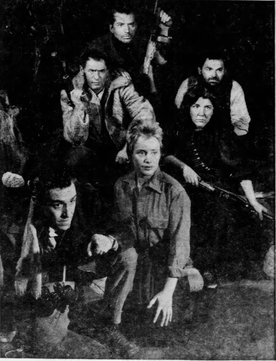
"For Whom the Bell Tolls" was an American television play broadcast in two parts on March 12 and March 19, 1959, as part of the CBS television series, Playhouse 90. It is a television adaptation of the 1940 novel by Ernest Hemingway. John Frankenheimer was the director. The cast included Jason Robards, Maria Schell, and Maureen Stapleton.
